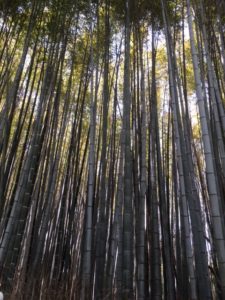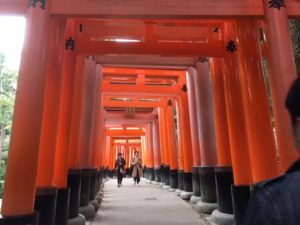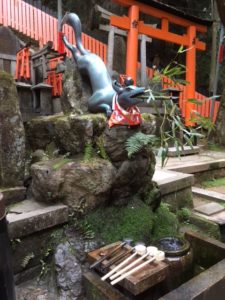
The bamboo grove at Arashiyama
Fifth in a Series
At first, it wouldn’t seem that heading to some of Kyoto’s most popular attractions during cherry-blossom season would qualify as an escape.
But the key to finding the peace and quiet we were seeking amid the throngs, my wife Catharine and I found, was to just keep walking — and climbing — once we got there.
On the same day we visited the Ryoan-ji Zen rock garden and the Kinkaku-ji temple (Golden Pavilion), we boarded an antique narrow-gauge railway that carried us in romantic style to Arashiyama on the western outskirts of Kyoto. (You can also take more modern trains from Kyoto station, or take a bus or the subway.)
It was obvious when we arrived that however they had gotten to Arashiyama, a good portion of everyone visiting Kyoto had conspired to visit at the same time as we.
It’s understandable. In addition to a number of temples and other sites, as well a raft of restaurants and shops, Arashiyama is home to one of Japan’s most exquisite bamboo groves, a forest of lofty green stalks that allow just enough sunlight to filter through so that alternating shades of light and shadow perform a kind of dance on their way from the sky to forest floor.
Like many attractions in Japan, entrance is free (a double-edged sword).
The bamboo forest is no doubt a place of peace and serenity in the off season or in early morning or late afternoon, but we had arrived at the height of midday, and as we entered we encountered a multitude of selfie-taking tourists who were intent on documenting their visit at each step along the pathway. With people streaming in every direction, stopping every few feet for photos, the simple act of strolling through the forest became more of a chore than a delight.
Just Keep Walking
But a remarkable thing happens when you just keep walking. The crowds and selfies dissipate, and the bamboo forest — which stretches forever, or so it seems — becomes almost yours alone.

The paths leading up Mt. Inari from the main shrine at Fushimi lead through hundreds of vermillion gates.
Rather than turning around and doubling back through the mobs, we had vast swaths of bamboo almost to ourselves, as we made a complete hour-long loop back to the main street. Along the way we passed neat little houses bordering the grove, quiet little streets, and welcome shade from the sun.
Eventually we re-emerged from the bamboo, admired the gardens of the Tenryu-ji temple — some of the finest in Kyoto — and made our way to Togetsu-kyo, the bridge crossing the Hozugawa River that serves as chief landmark and meeting point in Arashiyama.
You can relax along the riverbank or take riverboat trips from there, visit a nearby monkey park, or, of course, eat or shop on your way back to the train station.
An Extraordinary Shrine Complex
A subsequent day was devoted to visiting Fushimi Inari Taisha, one of the Kyoto area’s most remarkable shrines — and sights of any kind. It’s Japan’s main shrine to the Shinto Inari, a spirit that is said to protect the all-important rice crops — the staple of the Japanese diet and basis of sake as well, for which we can all be grateful.
Hopping on a train at Kyoto Station, we reached the shrine in just a few minutes, and at mid-morning the crowds were already thick.
After touring the main shrines near the entrance, we headed up a wooded pathway lined on either side by bright vermillion gates (torii), which seemed to snake endlessly up a mountainside. We were glad we packed our collapsible walking sticks — they were to prove invaluable that day.
At first, as we climbed the gate-lined steps, we had a fair amount of company, with visitors snapping — you guessed it — selfies as they went along. But the higher we climbed up Mt. Inari, the more the crowds thinned out.

A mini-shrine en route to the top of Mt. Inari.
Along the way, we noticed scores of little shrines, many adorned with stone foxes. The fox, we learned, is regarded in Shinto tradition as the messenger of Inari. Some had been garbed in little kerchiefs.
Soon we began to realize why Fushimi Inari-Taisha is known as the shrine with 10,000 gates and 12,000 steps. While I didn’t count them myself, I have no reason to dispute this.
But we kept climbing, and noticed that except for a few older Japanese, we were just about the only folks of our age still going. When we stopped for a rest at a bench about halfway up, a woman praised our “courage.”
Although that seemed a little insulting of two reasonably fit baby boomers, my legs argued otherwise, so I asked Catharine if she still wanted to continue. “Of course!” she replied, and that was all the encouragement I needed.
When we finally reached the top, after covering two to three miles of upward steps and passing scores of mini-shrines, stone foxes, and little refreshment stands, as well as the occasional panoramic view of Kyoto, we began the long trek down — actually more difficult for me than going up (knees).
We would be reminded of the hike for days afterwards in the form of creaky knees and joints — while I increasingly longed for beds that were raised off the floor — but we did have a plan for recovery: a relaxing trip to the public baths.
Photos by Catharine Norton
Next up: The Rituals of Public Bathing in Japan












Leave a Reply